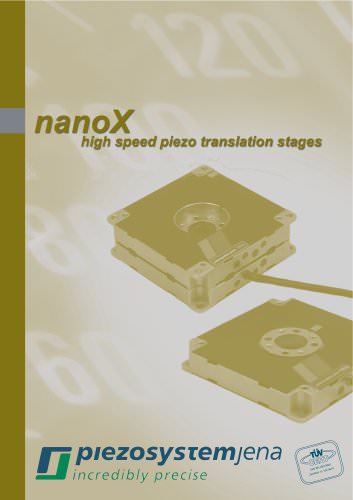
Catalog excerpts

THEORY - HIGH POWER ACTUATORS Piezocomposite Actuators Cofired Multilayer Actuators For the past few decades “cofired” multilayer stacks has been the state of the art method used for constructing piezo actuators. However there are a variety of applications where multilayer stacks reach their natural limitations. Multilayer stacks consist of many ceramic layers (each approx. 100 µm in thickness) with thin (1 µm) electrodes between them. After stacking these layers the compound is then sintered at high temperatures (cofiring). Figure 1: Piezocomposite stack actuator made from single piezoceramic discs and intermediate metal electrodes Multilayer actuators are operated with low voltages up to 200 V. Design of Piezocomposite Actuators Piezocomposite Ring Actuators are preferred for Piezocomposite actuators are made from completely sintered single PZT discs (thickness 0.3 to 0.5 mm) and separate intermediate metal foil electrodes which are held together by special high quality adhesives. Therefore these discretely stacked actuators are a composite material with some outstanding properties. • ptical applications O • pplications with high frequencies requiring effective A cooling and special thermal behavior • pplications with high bending stability A Piezocomposite actuators should be used to generate: According to • igh forces up to 50 kN H • igh accelerations up to 100’000 m/s2 H • hort pulses S • o withstand loads up to 70 kN T posite Actuators increases with the cross section and decreases with the length of the actuator. Piezocomposite Actuators with a preload show an elastic modulus nearly as high as that of multilayer stacks. Piezocomposite Actuators Low Voltage Multilayer Stacks large cross sections generating high forces small, medium cross sections for low volume elements high dynamic applications, shock generations, shakers, vibration generation short impulse excitation positioning, scanning, integration into more dimensional positioning systems operating voltage max. electrical field strength 0.1 to 0.15 % related to the stack length force generation same order related to the same cross section positioning accuracy same for both types: depending on the electrical supply and environmental conditions electrical capacitance / volume production technology stacking of sintered ceramic plates stacking of non sintered ceramic layers and cofiring material variety operating temperature range electrical current for dynamic applications / per volume high current cross section of ceramics
Open the catalog to page 1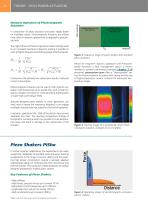
THEORY - HIGH POWER ACTUATORS Dynamic Operation of Piezocomposite Actuators In comparison to piezo actuators and piezo stages based on multilayer stacks, Piezocomposite Actuators are utilized more often in dynamic applications as opposed to positioning tasks. The high stiffness of Piezocomposite Actuators directly leads to an increased resonance frequency making it possible to work at higher frequencies and driving larger external masses. Figure 2: frequency range of piezo shakers and standard piezo actuators Furthermore the relatively low capacitance results in reduced current consumption....
Open the catalog to page 2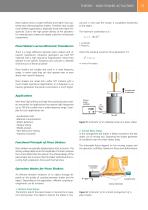
THEORY - HIGH POWER ACTUATORS Piezo shakers show a higher stiffness and higher force potential than electromagnetic shakers. Therefore they usually cover different applications, especially those with higher frequencies. Due to the high power density of the piezoelectric material piezo shakers are ideally suited for miniaturized components. Piezo Shakers versus Ultrasonic Transducers There is a huge difference between piezo shakers and ultrasonic transducers. Ultrasonic generators use hard PZT materials with a high resonance magnification. Hence they operate at one specific frequency but...
Open the catalog to page 3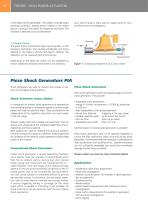
THEORY - HIGH POWER ACTUATORS of the object will be generated, if the object is clamped tight (blocking condition). Adding seismic masses to the shaker allows a tuning of the system for frequency and forces. The vibration is detected via an accelerometer. Such kind of setup is often used for experiments for structure-borne sound investigations. 3. Clamped Setup: The piezo shaker and the test object are mounted in a stiff clamping mechanism. The resulting amplitudes and forces depend on the shaker’s and the test object’s stiffness. The vibrations can be measured with a force sensor....
Open the catalog to page 4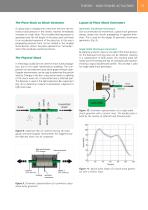
THEORY - HIGH POWER ACTUATORS 97 The Piezo Stack as Shock Generator Layout of Piezo Shock Generators If a piezo stack is charged with a very short rise time, the me- chanical axial pressure in the ceramic material immediately increases to a high value. This so-called blocking pressure is generated over the full length of the piezo stack and leads to an accelerated expansion of the piezo bar. In this way a propagating pressure front can be created in the coupled shock-partner. Hence, the piezo represents an "active-bar", which then produces mechanical shocks. In metrology usually bars are...
Open the catalog to page 5
THEORY - HIGH POWER ACTUATORS Electrical Operation of Piezo Shock For piezoelectric shock generation the piezo's capacitance has to be charged very fast. Considerations about position accuracy or voltage noise are irrelevant in such applications. To reach electrical rise times in the microseconds range extremely high currents are necessary. These currents are provided using high power pulse switches as shown in A capacitor bank (several 100 uF) is charged to the selected voltage (up to 1000 V). The piezo is then rapidly charged to the selected voltage via a small resistor leading to the ac-...
Open the catalog to page 6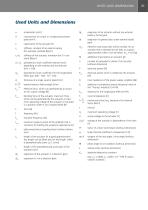
Used Units and Dimensions a cross section of a stack or a single piezoceramic plate [mm²] expansion of an actuator without any external loads or forces [μm] expansion in general (also under external loads) [μm] effective mass (mass that will be moved), for an actuator that is clamped at one side, as a good approximation often it can be taken: meff ≈ m/2 [g] additional mass load to an actuator [g] number of piezoelectric plates of an actuator [without dimension] stiffness, constant of an external spring (for example: preload) [N/μm] stiffness of the actuator, translator (for E = constant)...
Open the catalog to page 7All Piezosystem jena GmbH catalogs and technical brochures
-
SL 04-Series
2 Pages
-
SL 03-Series
2 Pages
-
SL 02-Series
2 Pages
-
XY Stage
4 Pages
-
24DV40
3 Pages
-
A Johson Electric Company
40 Pages
-
PosiCon 1000
2 Pages
-
HVP 1000/200
3 Pages
-
HVP 300/20
3 Pages
-
d-Drive
2 Pages
-
30DV50 & 30DV300
3 Pages
-
ENV
4 Pages
-
LCS - Series
2 Pages
-
SP-DS Series
2 Pages
-
SP-TR Series
2 Pages
-
MI-Series
2 Pages
-
SP 15000 C Series
2 Pages
-
NMM-1
2 Pages
-
EPP-Series
2 Pages
-
LM-Series
2 Pages
-
Series PA
4 Pages
-
series N
3 Pages
-
Fiberswitches/Multiplexers
16 Pages
-
Piezocomposite actuators
8 Pages
-
Piezo-Actuators
27 Pages
-
Accessories
2 Pages
-
PSH25 OEM
3 Pages
-
series nanoSXY 120
2 Pages
-
series nanoSX 400
2 Pages
-
Ring actuators series R/ RA
2 Pages
-
Piezo actuators series N
3 Pages
-
fiber switches/multiplexers
16 Pages
-
nanoMIPOS 400
2 Pages
-
Mikroskopie
4 Pages
-
TRITOR 101 and 102
4 Pages
-
TRITOR 100
2 Pages
-
TRITOR 38
2 Pages
-
miniTRITOR+microTRITOR
2 Pages
-
Piezo-Composites-Actuators
8 Pages
Archived catalogs
-
General Catalog
98 Pages
-
Optical Catalogue
15 Pages




























































